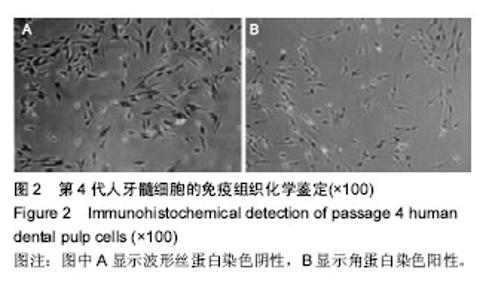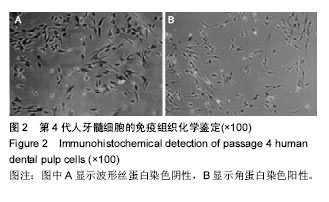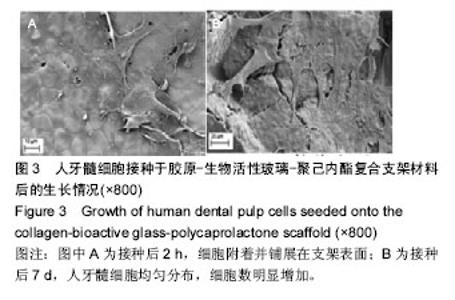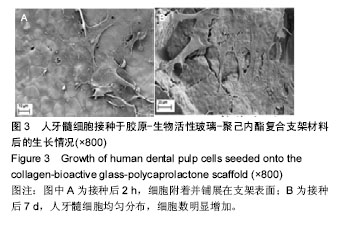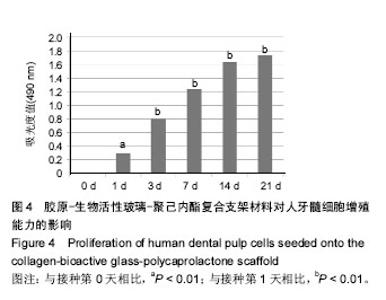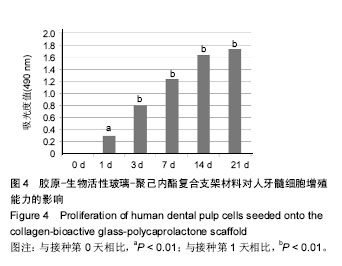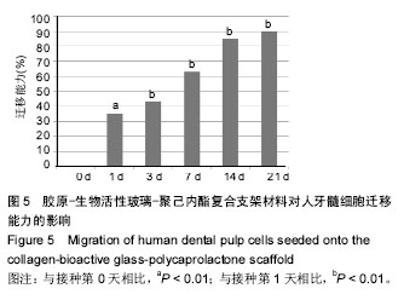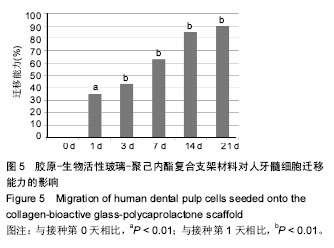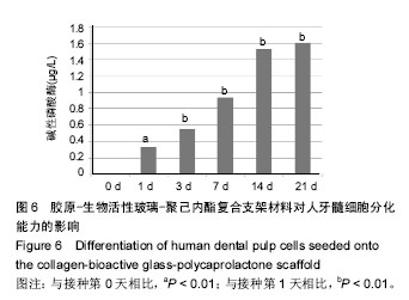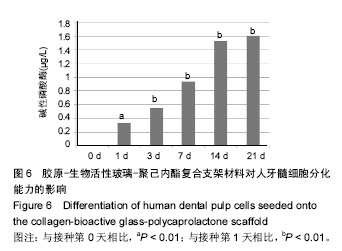| [1] Young F,Sloan A,Song B.Dental pulp stem cells and their potential roles in central nervous system regeneration and repair.J Neurosci Res.2013;91(11):1383-1393.[2] Huang GT.Pulp and dentin tissue engineering and regeneration: current progress.Regen Med.2009;4(5): 697-707.[3] 魏蔷薇,董艳梅,陈晓峰,等.人牙髓细胞在3种生物活性支架上的生长能力[J].北京大学学报,2013,45(3):484-488.[4] Bartold PM,McCulloch CA,Narayanan AS,et al.Tissue engineering: a new paradigm for periodontal regeneration based on molecular and cell biology.Periodontol 2000. 2000;24:253-69. [5] 刘琳,包广洁.牙髓牙本质组织工程生物支架材料的研究进展[J].中国组织工程研究.2013,17(8):1455-1460.[6] La Noce M,Paino F,Spina A,et al.Dental pulp stem cells:state of the art and suggestions for a true translation of research into therapy.J Dent.2014;42(7):761-768.[7] 米姗姗.董艳梅.高学军.溶胶-凝胶生物活性玻璃对人牙髓细胞作用的研究[J].北京大学学报,2012,44(1):39-42.[8] Venugopal J,Zhang YZ.Ramakrishna S,et al.Fabrication of modified and functionalized polycaprolactone nanofibre scaffolds for vascular tissue engineering.Nanotechnology. 2005;16(10):2138-2142.[9] 邹玉红.不同生物活性胶原支架对人牙髓细胞生长能力的影响及可能分子机制的探讨[J].海南医学院学报, 2015,21(10): 1325-1328. [10] Coyac BR,Chicatun F,Hoac B,et al.Mineralization of dense collagen hydrogel scaffolds by human pulp cells.J Dent Res.2013;92(7):648-54.[11] Bae WJ,Min KS,Kim JJ,et al.Odontogenic responses of human dental pulp cells to collagen/nanobioactive glass nanocomposites.Dent Mater.2012;28(12):1271-1279.[12] Piva E,Silva AF,Nör JE.Functionalized scaffolds to control dental pulp stem cell fate.J Endod.2014;40(4 Suppl):S33-40.[13] 王馨,屈雷,窦忠英,等.组织工程生物支架材料[J].中国生物工程杂志,2003,23(10):15-22.[14] Lee CH,Singla A,Lee Y.Biomedical applications of collagen.Int J Pharm.2001;22(1):1-22.[15] Day RM.Bioactive glass stimulates the secretion of angiogenic growth factors and angiogenesis in vitro.Tissue Eng.2005;11(5-6):768-777.[16] Prescott RS,Alsanea R,Fayad MI,et al.In vivo generation of dental pulp-like tissue by using dental pulp stem cells,a collagen scaffold,and dentin matrix protein 1 after subcutaneous transplantation in mice.J Endod. 2008;34(4): 421-426.[17] Lee KY,Mooney DJ.Hydrogels for tissue engineering.Chem Rev.2001;101(7):1869-1879.[18] Keshaw H,Forbes A,Day RM.Release of angiogenic growth factors from cells Encapsulated in alginate beads with bioactive glass.Biomaterials.2005;26(19):4171-4179.[19] Leppäranta O,Vaahtio M,Peltola T,et al.Antibacterial effect of bioactive glasses on clinically important anaerobic bacteria in vitro.J Mater Sci Mater Med.2008;19(2):547-551.[20] Mansoorianfar M,Shokrgozar MA,Mehrjoo M,et al. Nanodiamonds for surface engineering of orthopedic implants:Enhanced in human osteosarcoma cell culture.Diam Relat Mater.2013;40:107-114.[21] Bielby RC,Christodoulou IS,Pryce RS,et al.Time-and concentration-dependent effects of dissolution products of 58S sol-gel bioactive glass on proliferation and differentiation of murine and human osteoblasts.Tissue Eng. 2004;10(7-8): 1018-1026.[22] 吕孝帅,李正茂,杨雪超.生物活性玻璃58S/丝素蛋白膜促进人牙髓干细胞增殖与分化[J].牙体牙髓牙周病学杂志, 2015,25(10): 577-583.[23] 张俊,肖艳,徐衡,等.官能团化聚己内酯的制备及其生物应用[J].高分子通报,2016,5(3):13-26.[24] 苏佳灿,李明,禹宝庆,等.纳米羟基磷灰石/聚己内酯复合生物活性多孔支架研究[J].无机材料学报,2009,24(3):485-490.[25] 徐艺展,何丹,肖秀峰,等.羟基磷灰石/聚己内酯生物复合材料的制备及其生物活性[J].华南理工大学学报,2006,32(6):709-713.[26] Yang X,Yang F,Walboomers XF,et al.The performance of dental pulp stem cells on nanofibrous PCL/gelatin/nHA scaffolds.J Biomed Mater Res A.2010;93(1):247-257.[27] Qin C,Baba O,Butler WT.Post-translational modifications of sibling proteins and their roles in osteogenesis and dentinogenesis.Critev Oral Biol Med.2004;15(3):126-136.[28] Gong W,Huang Z,Dong Y,et al.Ionic extraction of a novel nano-sized bioactive glass enhances differentiation and mineralization of human dental pulp cells.J Endod. 2014; 40(1):83-88.[29] Li X,Xie J,Yuan X,et al.Coating electrospun poly (epsiloncarprol-actone) fibers with gelatin and calcium phosphate and their use as biomimetic scaffolds for bone tissue engineering.Langmuir.2008;24(24):14145-14150.[30] Venugopal J,Zhang YZ,Ramakrishna S.Fabrication of modified and functionalized polycaprolactone nanofibre scaffolds for vascular tissue engineering.Nanotechnology. 2005;16(10):2138-2142.[31] Feng R,Lengner C.Application of Stem Cell Technology in Dental Regenerative Medicine.Adv Wound Care. 2013;2(6): 296-305.[32] Wang X,Sha XJ,Li GH,et al.Comparative characterization of stem cells from human exfoliated deciduous teeth and dental pulp stem cells.Arch Oral Biol.2012;57(9):1231-1240.[33] Miller WA,Everett MM,Cramer JF.Growth of bovine pulp cells in monolayer culture.J Endod.1976;2(12):385.[34] Tsukamoto Y,Fukutani S,Shin-Ike T,et al .Mineralized nodule formation by cultures of human dental pulp-derived fibroblasts. Arch Oral Biol.1992;37(12):1045.[35] 汪平,郝建军,史俊南.体外培养的人牙髓细胞、牙周韧带细胞几种基质表达和碱性磷酸酶分泌的研究[J].牙体牙髓牙周病学杂志,1996,6(4):198.[36] 温泉,赵玉鸣,王媛媛,等.基质细胞衍生因子对人牙髓干细胞增殖迁移和成牙本质能力的影响[J].北京大学学报, 2016,48(1): 23-29. |


